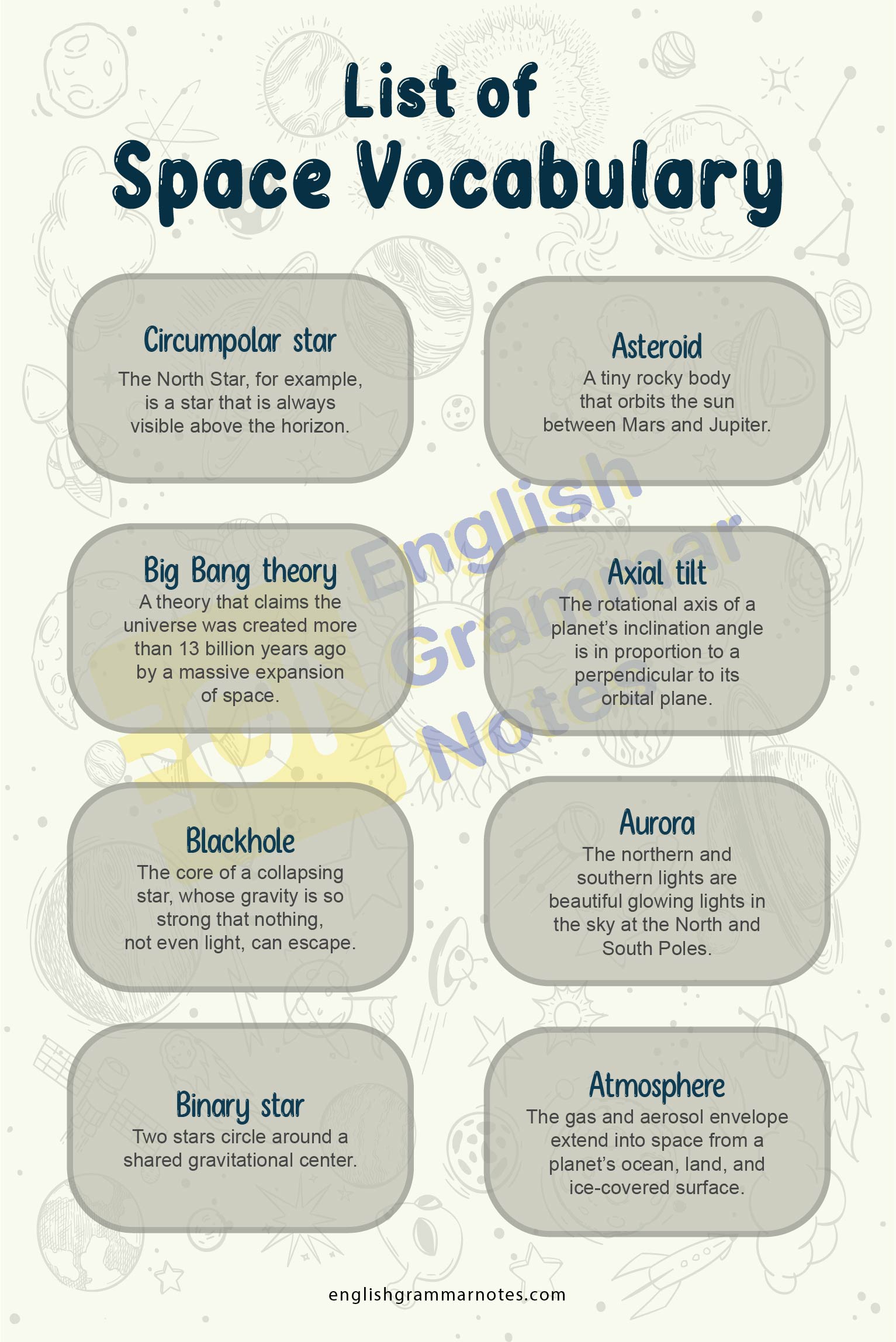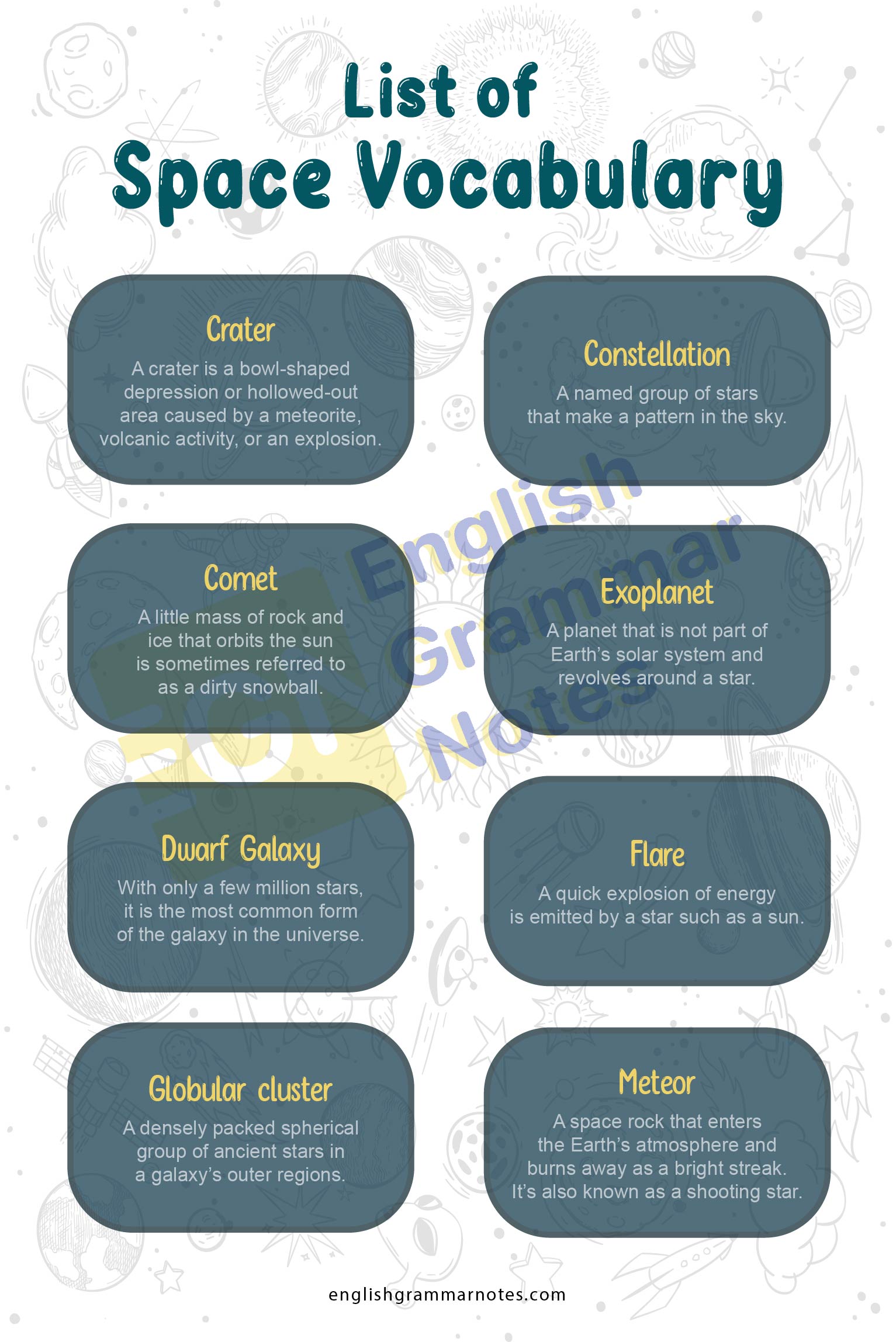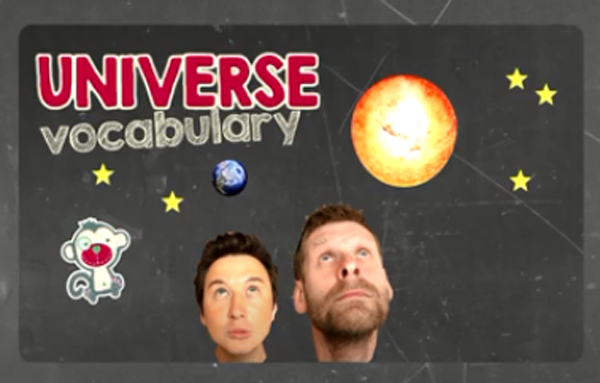Universe Space Vocabulary: Space is a vast expanse. Most of us use different types of outer space terms during a conversation. It is also a topic that receives much attention in the media, so you can expect to see many newspaper articles, TV series, and movies about space and the universe. As a result, to understand and communicate, you must recognize the terminology associated with this subject. Here is a list of space vocabulary that will help you learn space-related terms and make them easier to understand.
Study the most important English Vocabulary Words identified by our experts and learn the right vocabulary to use in your day to day conversations
List of Space Vocabulary Words in English
Name of Space Vocabulary Words
We are still exploring space, and the English language consists of various words associated with space and the universe. This article consists of space vocabulary with definitions and will help you better understand them.
List of Space Vocabulary words
- Asteroid
- Aurora
- Atmosphere
- Axial tilt
- Big Bang theory
- Binary star
- Blackhole
- Circumpolar star
- Comet
- Constellation
- Crater
- Crescent moon
- Dark matter
- Dwarf planet
- Dwarf Galaxy
- Eclipse
- Exoplanet
- Flare
- Full Moon
- Galaxy
- Gas planets
- Globular cluster
- Hypergalaxy
- Inferior planets
- Intergalactic
- Jet stream
- Kuiper belt
- Light-year
- Lunar eclipse
- Meteor
- Milky Way
- Moon
- Nebula
- Nova
- Orbit
- Parallax
- Partial eclipse
- Planet
- Quarter moon
- Quasar
- Red dwarf
- Red giant
- Satellite
- Shooting star
- Solar eclipse
- Solar system
- Star
- Supernova
- Transit
- Umbra
- Universe
- Variable star
- White hole
- X-class flares
- Yellow dwarf
- Zodiac
Description of the Space Vocabulary words.
Asteroid
A tiny rocky body that orbits the sun between Mars and Jupiter.
Aurora
The northern and southern lights are beautiful glowing lights in the sky at the North and South Poles.
Atmosphere
The gas and aerosol envelope extend into space from a planet’s ocean, land, and ice-covered surface.

Axial tilt
The rotational axis of a planet’s inclination angle is in proportion to a perpendicular to its orbital plane.
Big Bang theory
A theory that claims the universe was created more than 13 billion years ago by a massive expansion of space.
Binary star
Two stars circle around a shared gravitational center.
Blackhole
The core of a collapsing star, whose gravity is so strong that nothing, not even light, can escape.
Circumpolar star
The North Star, for example, is a star that is always visible above the horizon.
Comet
A little mass of rock and ice that orbits the sun is sometimes referred to as a dirty snowball.
Constellation
A named group of stars that make a pattern in the sky.
Crater
A crater is a bowl-shaped depression or hollowed-out area caused by a meteorite, volcanic activity, or an explosion.
Crescent moon
A crescent shape is a sign or emblem used to represent the first quarter lunar phase or, more broadly, the moon itself.
Dark matter
This stuff, which cannot be seen but can be detected by its gravitational effect, makes up the vast majority of the cosmos.
Dwarf planet
A small planet-like object that does not fulfill the definition of a planet. Dwarf planets include Pluto, Eris, and Ceres.
Dwarf Galaxy
With only a few million stars, it is the most common form of the galaxy in the universe.
Eclipse
An astronomical event occurs when an astronomical object or spacecraft becomes momentarily hidden, either by passing into another body’s shadow or by another body passing between it and the viewer.
Exoplanet
A planet that is not part of Earth’s solar system and revolves around a star.
Flare
A quick explosion of energy is emitted by a star such as a sun.
Full Moon
The sun, Earth, and moon create a line when the moon has advanced 180 degrees from its new moon position. The moon’s disc is as near to being entirely illuminated by the sun as it can go.
Galaxy
A galaxy is a massive gathering of stars that spans billions of light-years. Galaxies usually form spiral or oval shapes.
Gas planets
They are enormous planets, sometimes known as failed stars, primarily composed of hydrogen and helium. Jupiter, Saturn, Uranus, and Neptune are all gas giants.
Globular cluster
A densely packed spherical group of ancient stars in a galaxy’s outer regions.
Hypergalaxy
Dwarf satellite galaxies surround a giant spiral galaxy. Hypergalaxies include the Milky Way and Andromeda.
Inferior planets
Planets in our solar system are located between the sun and the Earth. Mercury and Venus are examples of planets in this category.
Intergalactic
The region of space between galaxies.
Jet stream
High-velocity winds that blow in the highest levels of the Earth’s atmosphere and influence weather.
Kuiper belt
One can find many comets in this region of our solar system beyond Neptune’s orbit. Pluto is one of the most massive planets in this belt.
Light-year
The maximum distance that light may travel in a single year. Light years is how space distance is measured. One light-year is approximately 9.5 trillion kilometers long.
Lunar eclipse
A phenomenon created by the Earth passing between the sun and a full moon, casting a shadow on the moon.
Meteor
A space rock that enters the Earth’s atmosphere and burns away as a bright streak. It’s also known as a shooting star.

Milky Way
Our solar system and hundreds of billions of stars are housed in this spiral-shaped galaxy. It can be seen as a brilliant band across the sky with the naked eye.
Moon
A solar system astronomical body that orbits a planet, dwarf planet, or other body.
Nebula
This vast cloud of dust and gas in space contains the raw materials from which stars are formed.
Nova
A star burns brilliantly for a few months after a nuclear explosion before reverting to its original state.
Orbit
A celestial object’s curving journey around a star, moon, or planet.
Parallax
A visible shift in the position of a celestial object when viewed from two different angles. Scientists use it to calculate the distances between stars and the Earth.
Partial eclipse
When the Earth passes between the sun and the moon, the three celestial bodies do not make a straight line in space, resulting in a partial lunar eclipse.
Planet
A planet is a celestial body that orbits the sun, has enough mass for its self-gravity to overcome rigid body forces, achieves a hydrostatic equilibrium shape, and has cleared the area around its orbit.
Quarter moon
It is the moon phase that occurs halfway between the new and full moon.
Quasar
This gigantic, very luminous astronomical phenomenon, found in remote reaches of the universe, emits enormous energy and is fueled by a black hole.
Red dwarf
A cool little star with a lower brightness than the sun.
Red giant
A massive cold star that is nearing the end of its life emits a red glow.
Satellite
An object launched into space and orbited the Earth or another planet to gather data or communicate.
Shooting star
These are meteors created by tiny bits of dust from space that burn up 65 to 135 kilometers above the Earth’s surface before plunging at incredible speeds into the upper atmosphere.
Solar eclipse
The sun is entirely or partially covered as the Earth travels through the moon’s shadow.
Solar system
The region of our galaxy revolves around the sun. The Earth, the other seven planets, dwarf planets, moons, asteroids, and comets are all included.
Star
A massive burning gas ball in space that emits light, heat, ultraviolet radiation, and X-rays.
Supernova
An explosion occurs when a star dies, causing it to become incredibly bright for a few months.
Transit
A celestial body’s passage in front of a more extensive body or across the meridian.
Umbra
The shadow’s most profound and darkest area is cast by a lighted body, blocking all light. The umbra of the moon causes total solar eclipses.
Universe
Everything in existence. The entire universe, including planets, stars, galaxies, and various forms of matter and energy. The observable universe spans around 92 billion light-years.
Variable star
A star whose brightness varies.
White hole
A white hole spews out matter and light in contrast to a black hole that nothing can escape.
X-class flares
The sun’s most powerful eruptions. They have the potential to cause dangerous radiation storms and radio blackouts.
Yellow dwarf
The yellow dwarf is a medium-sized star, similar to the sun. Contrary to its name, it is often white. Only through the Earth’s atmosphere can the sun look yellow.
Zodiac
A fictitious belt in the sky, including the 12 zodiacal constellations.
